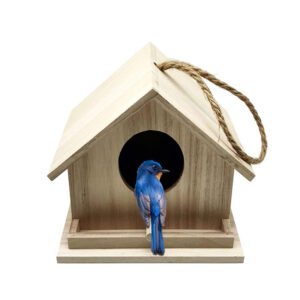Bird Living house are nature’s songsters, bringing life and color to our surroundings.
Building a bird living house is not just about constructing a shelter;Whether you’re an avid birdwatcher, a nature enthusiast, or simply someone who enjoys the serenity of their chirps, providing a welcoming habitat for birds can be immensely rewarding. it’s about inviting these feathered friends into our lives and giving them a safe space to thrive. In this blog, we’ll delve into the art of birdhouse building, exploring the steps, materials, and considerations involved in creating a haven for our avian companions.
Choosing the Right Design:
The first step in building a birdhouse is selecting the right design. Different bird species have varying preferences when it comes to their homes. Bluebirds, for instance, prefer open-fronted houses, while chickadees favor smaller, cozy spaces with a small entrance hole. Researching the specific requirements of the birds in your area is crucial in designing a birdhouse that will attract them.
Materials and Tools:
Once you’ve chosen a design, gather the necessary materials and tools. Common materials for birdhouses include untreated wood (such as cedar or pine), exterior-grade plywood, and non-toxic paints or stains.
It’s essential to avoid pressure-treated wood, as the chemicals used in the treatment can be harmful to birds. Additionally, make sure to use galvanized or stainless steel screws and hardware to prevent rust.
Basic Construction Steps:
Building a bird living house is a relatively straightforward process, even for those with minimal woodworking experience. Here’s a basic outline of the construction steps:
- Cut the pieces according to your chosen design, ensuring precise measurements for a snug fit.
- Assemble the walls, floor, and roof using weather-resistant glue and screws.
- Drill a hole for the entrance, making sure it’s the appropriate size for the target bird species.
- Add any additional features, such as perches or predator guards, depending on your design and local wildlife.
Placement and Maintenance:
Once your bird living house is constructed, proper placement is crucial for attracting tenants. Mount the birdhouse on a sturdy pole or tree trunk, preferably in a shaded area away from direct sunlight and prevailing winds. Make sure the entrance faces away from prevailing winds and predators, such as cats or raccoons.
Regular maintenance is also essential to ensure the longevity of the birdhouse. Inspect it annually for signs of wear and tear, such as loose screws or damage from weather exposure. Cleaning out old nests at the end of each breeding season will also help maintain hygiene and prevent the spread of parasites.
A bird living house is more than just a simple wooden structure; it’s a miniature sanctuary designed to provide shelter, safety, and comfort for our feathered friends. From its humble exterior to its carefully crafted interior, every aspect of a bird living house is tailored to meet the specific needs of the avian inhabitants it seeks to attract. Let’s embark on a detailed exploration of the anatomy of a bird living house:
- Exterior Design:
- Roof: The roof of a bird living house serves a dual purpose: it protects the interior from the elements while also providing drainage to prevent water from accumulating inside. The slope of the roof is carefully angled to shed rainwater and snow, keeping the nesting area dry.
- Walls: The walls of a bird living house are typically made from untreated wood, providing a natural and breathable environment for the birds. The exterior may be adorned with decorative elements such as carved patterns or painted designs, adding aesthetic appeal while blending harmoniously with the surrounding environment.
- Entrance Hole: The entrance hole is strategically positioned to provide easy access for the intended bird species while deterring predators. Its size and shape are meticulously calculated based on the preferences of the target birds, ensuring a snug fit that prevents larger predators from entering.
- Interior Features:
- Nesting Chamber: Within the confines of the bird living house, the nesting chamber serves as a cozy retreat for brooding birds and their hatchlings. The interior dimensions are optimized to accommodate the specific nesting habits of the target species, with ample space for nesting materials and unhindered movement.
- Perches: Small perches or ledges may be installed inside the bird living house to provide a convenient landing spot for the inhabitants and facilitate easy entry and exit. These perches are positioned strategically to prevent obstruction while maximizing comfort and accessibility
Conclusion: Building a bird living house is more than just a DIY project; it’s an opportunity to connect with nature and contribute to the conservation of bird populations.

